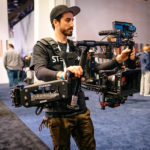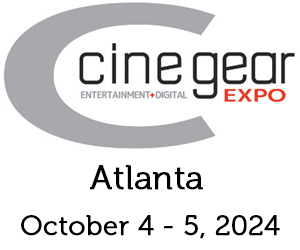
Shooting on Prime Lenses in Antarctica
Posted on Feb 17, 2016 by Alex Fice
With the British Antarctic research station at Halley in the background from left to right on sound was Doug Dreger, the presenter Peter Gibbs and David Baillie with his Arri Alexa Mini camera.
Polar expert DoP David Baillie had just bought an ARRI Alexa Mini camera when he got a six week booking to shoot in the Antarctica for the BBC Horizon programme. Against his better judgement he decided to shoot it all on Prime lenses.
A few years ago I decided that with possible retirement on the horizon I’d resist the temptation to buy another camera. But last year, as the financial pressures of no-pension freelance living pushed retirement completely out of sight, I reconsidered. Being just a jobbing DoP I knew that wisely managed, having my own kit can make the whole business more financially viable than turning up on set with hands in pockets.
 The Arri Mini rig in the blue of the Antarctic.
The Arri Mini rig in the blue of the Antarctic.
2015 was a pretty eclectic year for me with both drama and documentary DoP’ing. I’d also found my helicopter based aerial work decanted onto drones. So across the year I was hiring a mixture of Amiras, Alexa Classics, PMW500s, Reds, and against my better judgement, occasionally forced to resort to the BBC’s knee-jerk obsession for a C300.
So the question was what single camera could cover this hot-potch? As I needed a drama quality drone capability, the choice soon came down to a Red or an Alexa Mini. And as I don’t have a PhD and have therefore never begun to find my way around a Red menu, I went for the Mini. No sooner than I had paid my deposit to get on the Mini waiting list, I found myself with a six week BBC Horizon booking in Antarctica. I knew I could turn the Mini into a good ‘A’ camera for normal drama and documentary shooting, but having done quite a bit of very remote and very cold polar work I knew this would be no ordinary shoot.
My 2015 drama work meant I’d mainly been working with primes and become used to playing with shallow depth of fields as I’d always had the luxury of some very good 1st ACs to focus pull. The Antarctic subject was the remote Halley research base where the logistics means the media are rarely given access. My footage would really have to count, so I rashly decided to shoot on the Alexa, using just my Canon CN primes (14/24/50/85/135mm), without any assistant and in temperatures down to minus 25˚C.
 David with Arri Mini abseiling down the ice crack.
David with Arri Mini abseiling down the ice crack.
I’d previously shot with a venerable DigiBeta in minus 55 at Vostok base in the centre of Antarctica so have a fairly relaxed attitude to cameras working in the cold. But battery life is always an unknown, even in Halley’s balmy minus 20. After a useful conversation with Jason Stewart at HawkWoods I decided to invest in some 26V batteries rather than rely on my ageing 14V V locks. Jason kindly loaned me a couple more for reassurance but on no day did I need more than 2 RealPower 150Wh batts; they were superb.
As in all the best shoots, I had a last minute crisis before leaving the UK when I carelessly trashed the pins on my Mini’s viewfinder cable. Delivery through all the normal channels was six weeks with none available even at Arri in Munich. However Bobby Mehr at Visual Impact worked some magic and got me one just in time. Now quite paranoid, I desperately looked for an additional spare and again found salvation with a loan of one thanks to the brilliant help of Simon Surtees at Arri UK.
 A frame grab from the Arri colour tool.
A frame grab from the Arri colour tool.
Much of the six weeks was spent getting to and from Halley where we had just eight shoot days. Even with 24 hour daylight time would still be of the essence for an hour programme. I was helped by being part of a great team. Firstly my producer, Simon Winchcombe, was experienced enough to be very relaxed about constant lens changes.
Secondly our presenter, BBC weatherman Peter Gibbs, is the ultimate “one take wonder”, saving all the time that often haemorrhages on multi-take PTCs. And finally Doug Dreger on sound was so forensically professional that I could totally forget that side of the process. He also accepted without complaint my boom-challenging love for the 14mm, and was always there with an extra hand during lens changes.
The lens changes could be problematic, especially in snow where flakes did occasionally find their way on the Mini’s internal ND filters. Inspecting the filters in the field was hampered by the perennial problem of waiting for eyes to adapt to working with and without the sunglasses that were essential to prevent snow blindness, but which had to be removed for any detailed viewfinder work.
 A frame grab from the Arri colour tool. Click below for the full HD grab.
A frame grab from the Arri colour tool. Click below for the full HD grab.
For most of the time at Halley the sun failed to break through the overcast clouds. Definition of snow drifts even a few feet away disappeared into a low contrast, horizonless white-out. This was a particular problem when we abseiled into the crack that is threatening to split the Brunt Ice Shelf in half. The scientists have drone footage of the crack in sunlight and it looks stunning. But shooting back up from the bottom of the crack I could barely distinguish between the ice walls and the sky above.
All I knew that with the Alexa’s latitude I was at least giving the grader the best chance of pulling something out of nothing. The abseil and an attempt to film a conversation between Peter and a glaciologist half way down did prove a step too for my prime fundamentalism since the overhanging cliff meant we were all spinning in space and I regretted fitting the 24mm rather than the 14mm, or having a wide zoom.
I grew to quite like the overcast look and played around with some grades on Arri Colour Tool which made a feature of it; a sort of Fargo meets The Thing.
So what’s the final judgement on the Alexa Mini and working with primes in a very challenging place? Well the Mini passed with flying colours; beautiful rendition of difficult light, and compact enough for rope work. As for the primes, there were times when I did push the stop too wide and in the chaos of steamed up viewfinders and snow blindness, missed the mark. But hopefully no show stoppers. Another time I’d probably stop down for more wriggle room, but having said that, solo shooting a documentary with primes can give a very special place, a very special look.
David Baillie
 Another frame grab, this time a 4K one. Click below for the full 4K grab.
Another frame grab, this time a 4K one. Click below for the full 4K grab.
Click here for the full 4K grab.





















